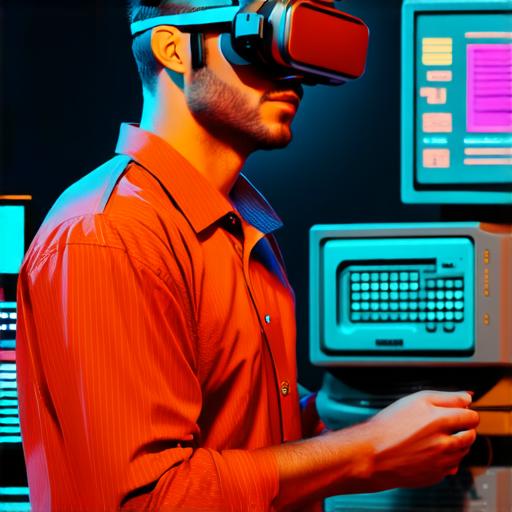Virtual reality (VR) technology has come a long way since its inception in the 1960s. From its humble beginnings to the immersive and interactive experiences we enjoy today, VR has revolutionized the way we interact with digital worlds.
The Beginnings of Virtual Reality
Virtual reality can be traced back to 1962 when Ivan Sutherland created the first VR headset known as the “Sword of Damocles”. The device consisted of a large, clunky headset that was suspended above the user’s head and was connected to a computer. This early version of virtual reality allowed users to experience a 3D environment from a fixed perspective, but it was limited in its ability to track movements or provide a sense of immersion.
In the following years, other pioneers in VR technology emerged. In 1968, Jaron Lanier created the first interactive VR system called “The Eye Writer”. The device allowed users to control a cursor on a screen using their eyes, providing a new level of interactivity and control. However, the limitations of these early systems were still apparent, as they relied heavily on external input devices and had limited tracking capabilities.
The Birth of Modern Virtual Reality
It wasn’t until the 1980s that virtual reality technology truly began to take off. This was largely due to advances in computer hardware and software, which enabled developers to create more immersive and interactive experiences.
One of the most influential figures in this period was Edward Catmull, a computer scientist who played a key role in developing the first 3D graphics software at Pixar. Catmull’s work on Z-buffer algorithms allowed for more realistic rendering of 3D objects, which paved the way for virtual reality.
In 1984, Catmull created the first VR system called “The Labyrinth”, which used a headset and gloves to track the user’s movements and provide a sense of immersion. The device was used primarily for research purposes, but it marked the beginning of a new era in virtual reality.
In 1985, Ed Catmull created a virtual reality system that used a headset and gloves to track the user’s movements and provided a more immersive experience than previous systems.
The 1990s saw further advances in VR technology, with the release of consumer-grade systems such as the Nintendo Virtual Boy and Sega Genesis 3D. These systems were largely unsuccessful, however, due to their limited tracking capabilities and high cost. It wasn’t until 1997 that the first commercial virtual reality system, the CyberMaxx, was released. The device used a headset and gloves to track the user’s movements and provided a more immersive experience than previous systems.
The 2000s brought about even greater advancements in VR technology, with the development of the Oculus Rift, HTC Vive, and PlayStation VR. These systems provided a level of immersion that was previously unimaginable, with realistic graphics, tracking capabilities, and interactive experiences that were limited only by the user’s imagination.
Since then, other VR systems have been released, including the HTC Vive Pro Eye and the PlayStation VR 5. These systems continue to push the boundaries of what is possible in virtual reality, with new features and capabilities that make them even more immersive and interactive.
The Modern Virtual Reality Era
Today, virtual reality technology has become an integral part of our daily lives. From gaming to education to healthcare, VR is changing the way we interact with digital worlds in unprecedented ways. The current state of VR technology can be traced back to 2016, when Oculus VR released the Oculus Quest 2. This device provided a level of immersion and interactivity that was previously unimaginable, with realistic graphics, tracking capabilities, and interactive experiences that were limited only by the user’s imagination.
Since then, other VR systems have been released, including the HTC Vive Pro Eye and the PlayStation VR 5. These systems continue to push the boundaries of what is possible in virtual reality, with new features and capabilities that make them even more immersive and interactive.
In addition to consumer-grade systems, there has also been a surge in the development of enterprise-grade VR systems for use in industries such as healthcare, education, and manufacturing. These systems are designed specifically for these applications, providing highly specialized features and capabilities that are not available on consumer-grade systems.
The Future of Virtual Reality
As virtual reality technology continues to evolve, there is no doubt that it will continue to play an increasingly important role in our daily lives. The potential applications of VR are virtually limitless, from gaming and entertainment to education and healthcare. In fact, some experts predict that virtual reality will become as ubiquitous as the internet itself within the next decade.

One of the most exciting areas of development in virtual reality is the integration of artificial intelligence (AI) and machine learning (ML). By combining these technologies with VR, developers can create even more immersive and interactive experiences that are tailored specifically to the user’s preferences and needs.
Another area of development is the integration of haptic technology, which allows users to feel physical sensations in virtual environments. This technology has already been used in some high-end VR systems, but it is likely to become more widespread in the future as it becomes more affordable and accessible.
Finally, there is a growing movement towards open-source VR development, with many developers sharing their code and resources online. This has led to the creation of a vibrant community of virtual reality developers who are constantly pushing the boundaries of what is possible in this rapidly evolving field.
Conclusion
Virtual reality technology has come a long way since its inception in the 1960s. From its humble beginnings to the immersive and interactive experiences we enjoy today, VR has revolutionized the way we interact with digital worlds. As virtual reality continues to evolve
